Recording Business Transaction
VerifiedAdded on 2022/12/28
|15
|2751
|34
AI Summary
The case study is about recording of business entries and transactions in various forms like T-accounts, trial balance, profit and loss statement and Balance sheet. It depicts how the transactions are recorded following accounting principles of the country. Each form of statement records entry in a different way but in the end helps a company keep order of its transactions, the capital involved, its remaining dues to creditors, the debtors and reflects the profit earned by the company in a financial term. These statements are also evaluated by shareholders to check the financial status of the company and form decision to invest. The study also does a ratio analysis and compares with competitors to reflect the standing of the company on various parameters to the competitors.
Contribute Materials
Your contribution can guide someone’s learning journey. Share your
documents today.
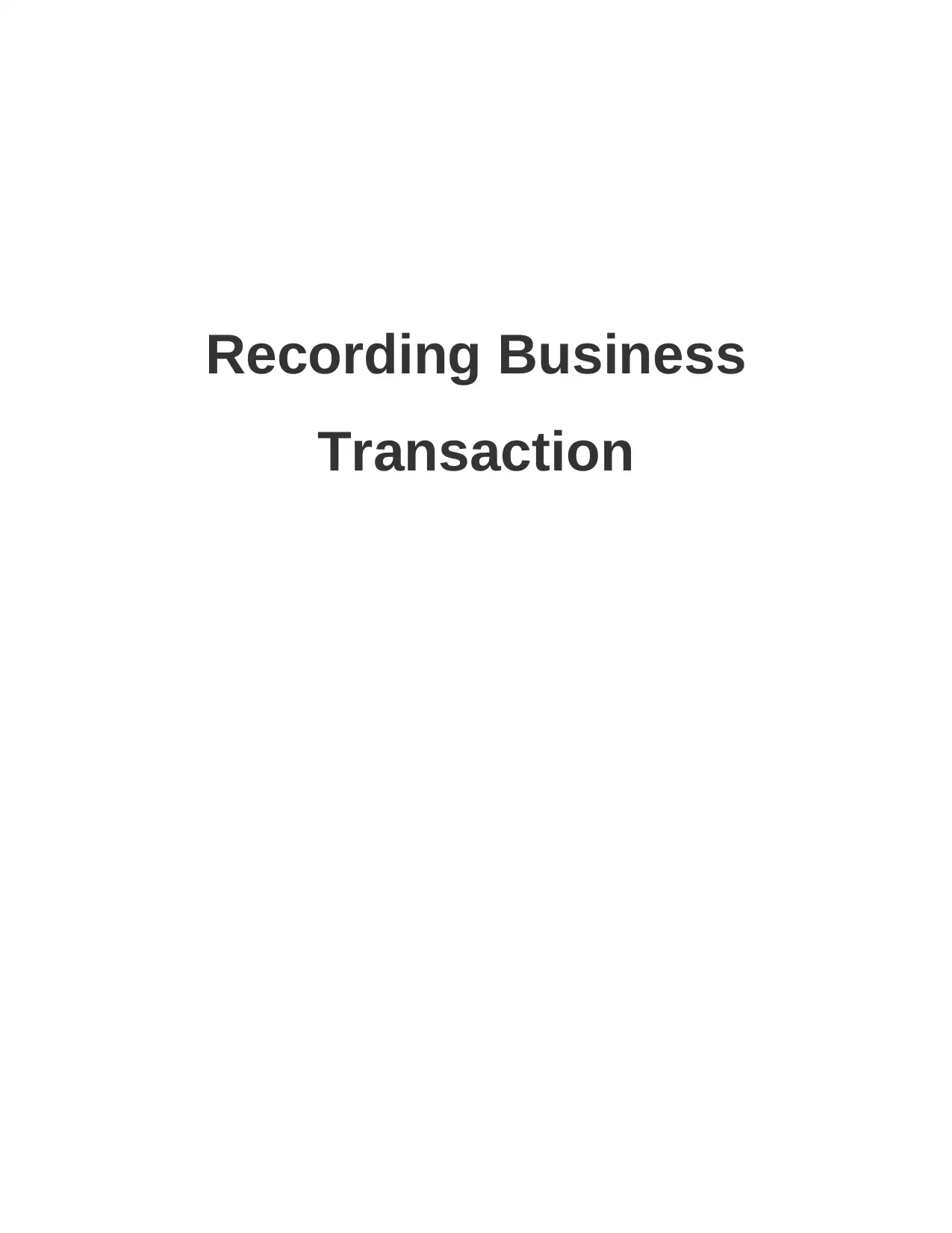
Recording Business
Transaction
Transaction
Secure Best Marks with AI Grader
Need help grading? Try our AI Grader for instant feedback on your assignments.
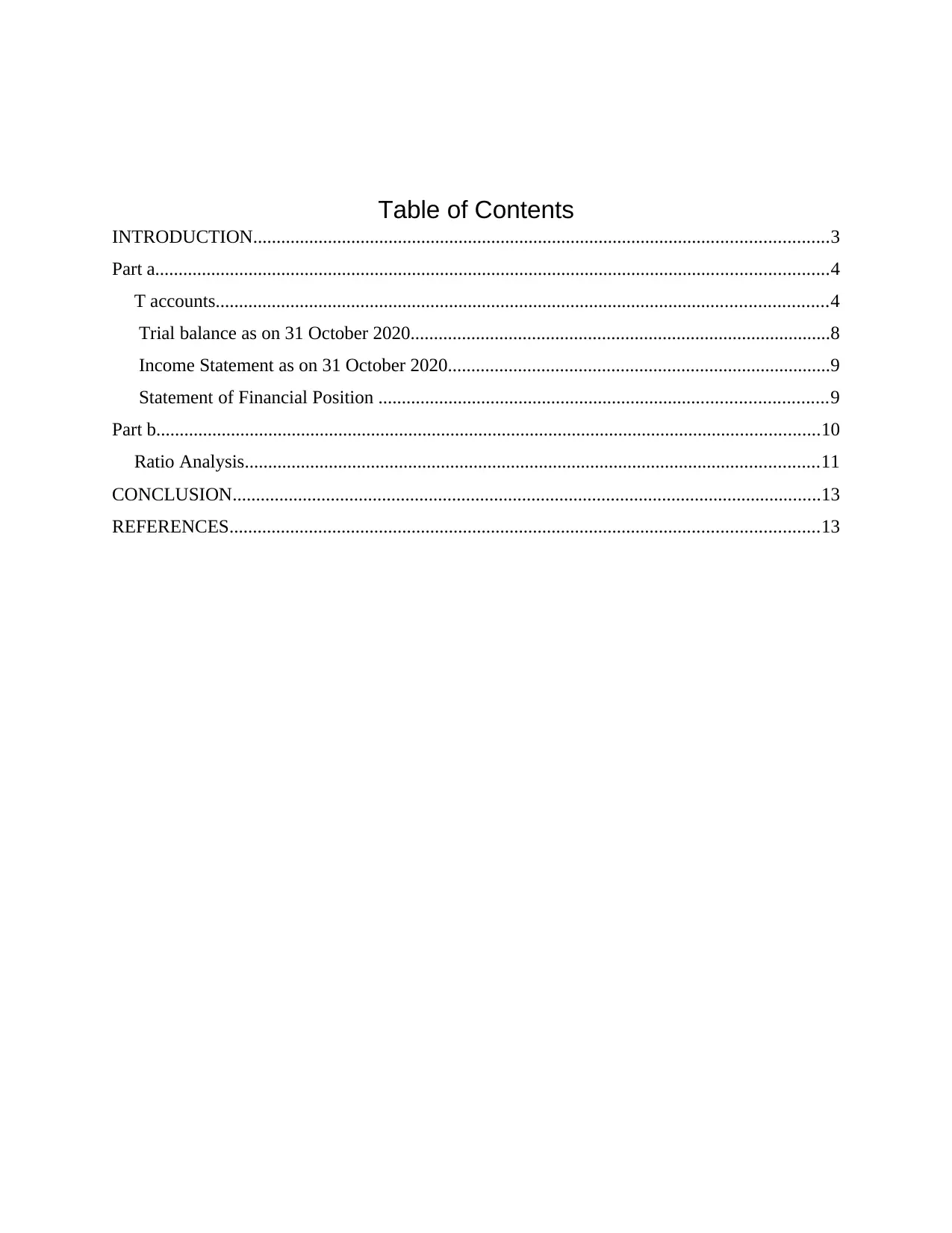
Table of Contents
INTRODUCTION...........................................................................................................................3
Part a................................................................................................................................................4
T accounts...................................................................................................................................4
Trial balance as on 31 October 2020..........................................................................................8
Income Statement as on 31 October 2020..................................................................................9
Statement of Financial Position ................................................................................................9
Part b..............................................................................................................................................10
Ratio Analysis...........................................................................................................................11
CONCLUSION..............................................................................................................................13
REFERENCES..............................................................................................................................13
INTRODUCTION...........................................................................................................................3
Part a................................................................................................................................................4
T accounts...................................................................................................................................4
Trial balance as on 31 October 2020..........................................................................................8
Income Statement as on 31 October 2020..................................................................................9
Statement of Financial Position ................................................................................................9
Part b..............................................................................................................................................10
Ratio Analysis...........................................................................................................................11
CONCLUSION..............................................................................................................................13
REFERENCES..............................................................................................................................13
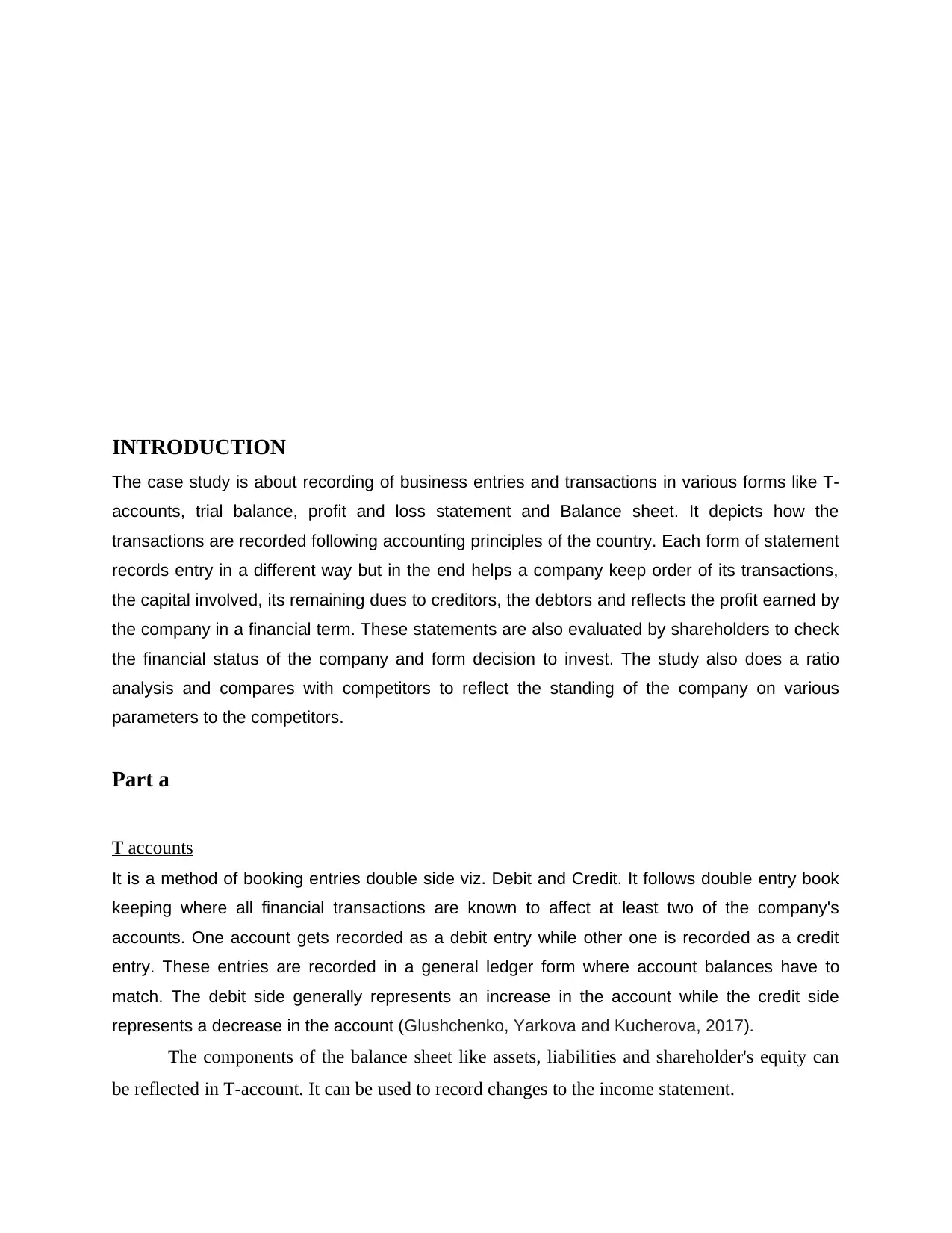
INTRODUCTION
The case study is about recording of business entries and transactions in various forms like T-
accounts, trial balance, profit and loss statement and Balance sheet. It depicts how the
transactions are recorded following accounting principles of the country. Each form of statement
records entry in a different way but in the end helps a company keep order of its transactions,
the capital involved, its remaining dues to creditors, the debtors and reflects the profit earned by
the company in a financial term. These statements are also evaluated by shareholders to check
the financial status of the company and form decision to invest. The study also does a ratio
analysis and compares with competitors to reflect the standing of the company on various
parameters to the competitors.
Part a
T accounts
It is a method of booking entries double side viz. Debit and Credit. It follows double entry book
keeping where all financial transactions are known to affect at least two of the company's
accounts. One account gets recorded as a debit entry while other one is recorded as a credit
entry. These entries are recorded in a general ledger form where account balances have to
match. The debit side generally represents an increase in the account while the credit side
represents a decrease in the account (Glushchenko, Yarkova and Kucherova, 2017).
The components of the balance sheet like assets, liabilities and shareholder's equity can
be reflected in T-account. It can be used to record changes to the income statement.
The case study is about recording of business entries and transactions in various forms like T-
accounts, trial balance, profit and loss statement and Balance sheet. It depicts how the
transactions are recorded following accounting principles of the country. Each form of statement
records entry in a different way but in the end helps a company keep order of its transactions,
the capital involved, its remaining dues to creditors, the debtors and reflects the profit earned by
the company in a financial term. These statements are also evaluated by shareholders to check
the financial status of the company and form decision to invest. The study also does a ratio
analysis and compares with competitors to reflect the standing of the company on various
parameters to the competitors.
Part a
T accounts
It is a method of booking entries double side viz. Debit and Credit. It follows double entry book
keeping where all financial transactions are known to affect at least two of the company's
accounts. One account gets recorded as a debit entry while other one is recorded as a credit
entry. These entries are recorded in a general ledger form where account balances have to
match. The debit side generally represents an increase in the account while the credit side
represents a decrease in the account (Glushchenko, Yarkova and Kucherova, 2017).
The components of the balance sheet like assets, liabilities and shareholder's equity can
be reflected in T-account. It can be used to record changes to the income statement.
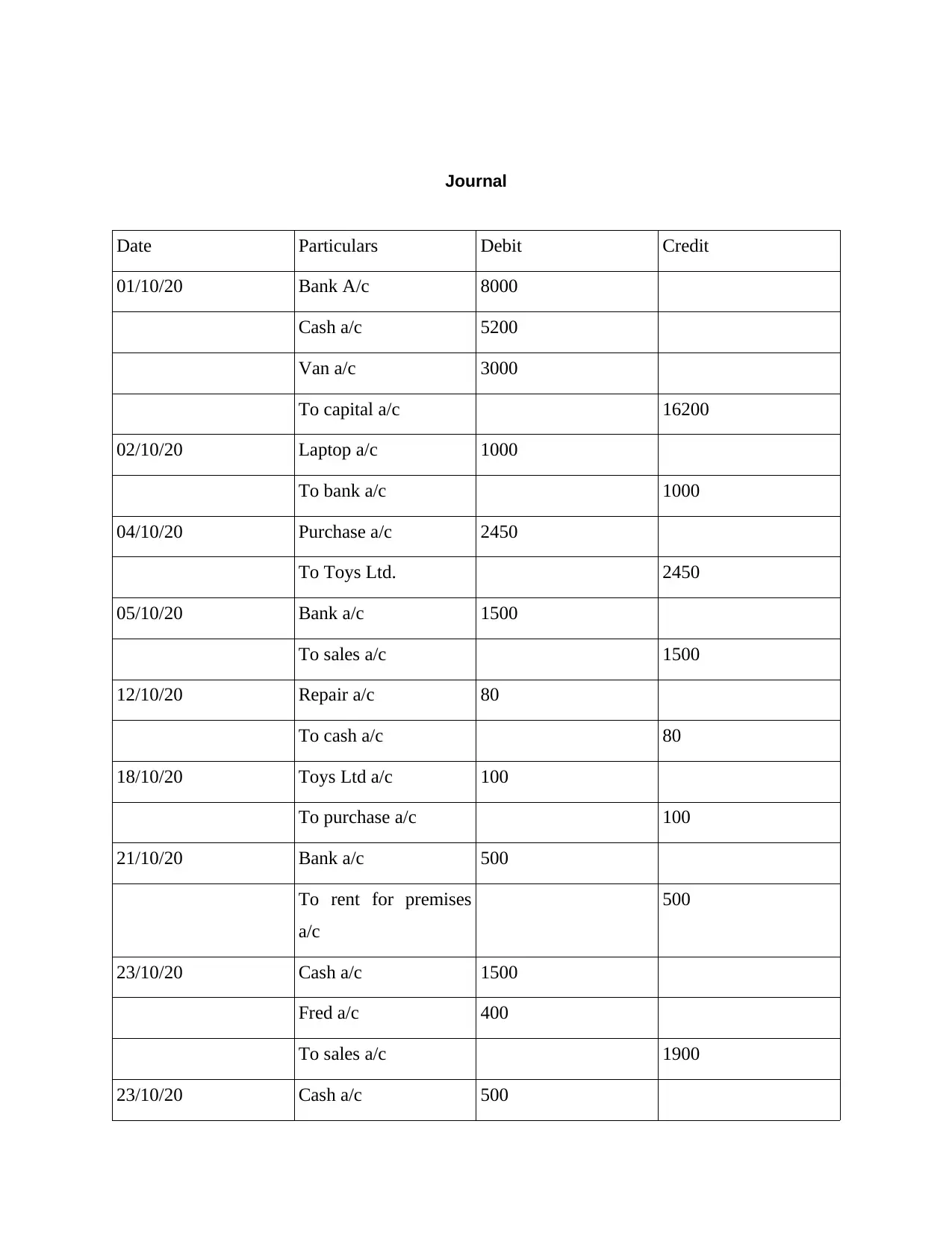
Journal
Date Particulars Debit Credit
01/10/20 Bank A/c 8000
Cash a/c 5200
Van a/c 3000
To capital a/c 16200
02/10/20 Laptop a/c 1000
To bank a/c 1000
04/10/20 Purchase a/c 2450
To Toys Ltd. 2450
05/10/20 Bank a/c 1500
To sales a/c 1500
12/10/20 Repair a/c 80
To cash a/c 80
18/10/20 Toys Ltd a/c 100
To purchase a/c 100
21/10/20 Bank a/c 500
To rent for premises
a/c
500
23/10/20 Cash a/c 1500
Fred a/c 400
To sales a/c 1900
23/10/20 Cash a/c 500
Date Particulars Debit Credit
01/10/20 Bank A/c 8000
Cash a/c 5200
Van a/c 3000
To capital a/c 16200
02/10/20 Laptop a/c 1000
To bank a/c 1000
04/10/20 Purchase a/c 2450
To Toys Ltd. 2450
05/10/20 Bank a/c 1500
To sales a/c 1500
12/10/20 Repair a/c 80
To cash a/c 80
18/10/20 Toys Ltd a/c 100
To purchase a/c 100
21/10/20 Bank a/c 500
To rent for premises
a/c
500
23/10/20 Cash a/c 1500
Fred a/c 400
To sales a/c 1900
23/10/20 Cash a/c 500
Secure Best Marks with AI Grader
Need help grading? Try our AI Grader for instant feedback on your assignments.
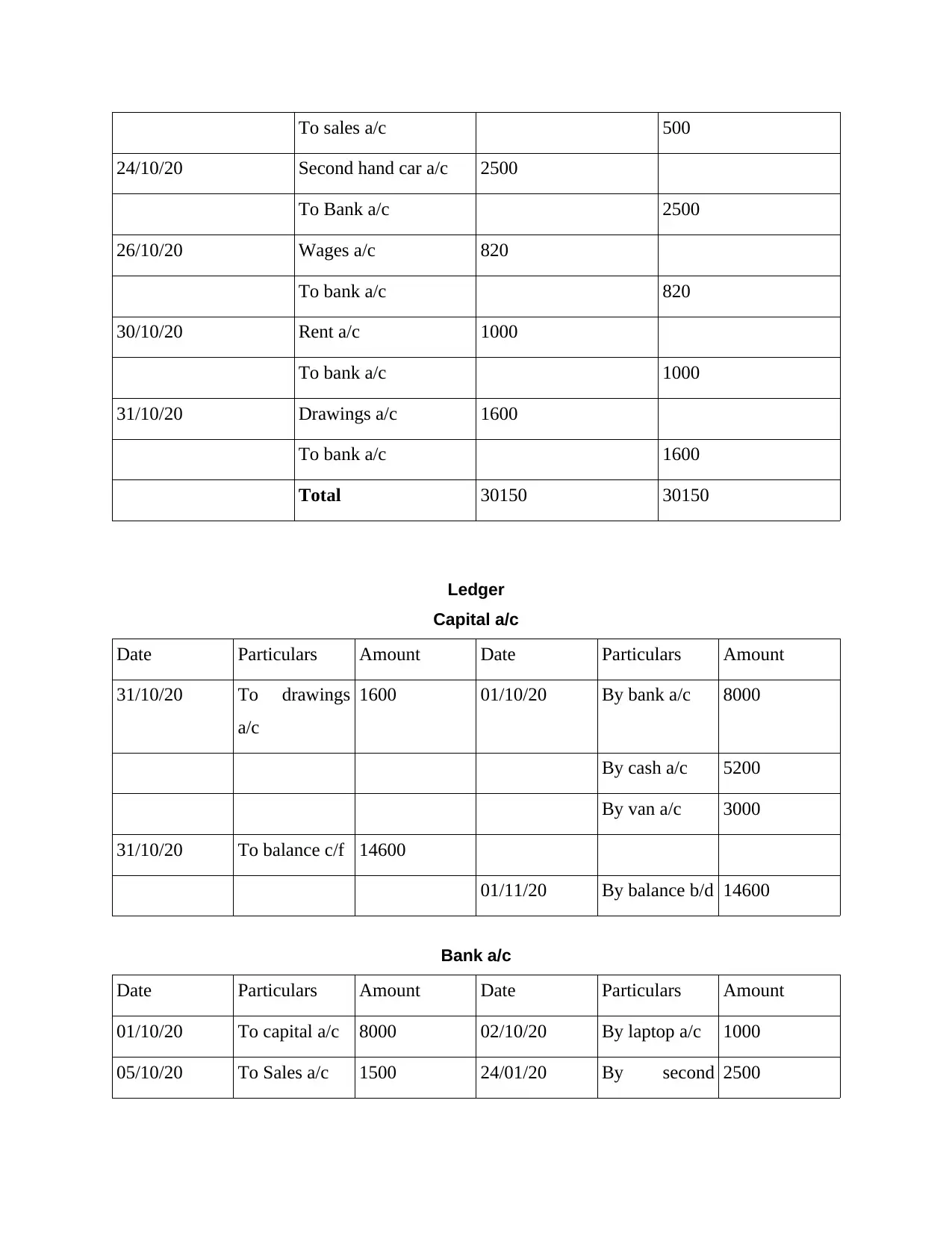
To sales a/c 500
24/10/20 Second hand car a/c 2500
To Bank a/c 2500
26/10/20 Wages a/c 820
To bank a/c 820
30/10/20 Rent a/c 1000
To bank a/c 1000
31/10/20 Drawings a/c 1600
To bank a/c 1600
Total 30150 30150
Ledger
Capital a/c
Date Particulars Amount Date Particulars Amount
31/10/20 To drawings
a/c
1600 01/10/20 By bank a/c 8000
By cash a/c 5200
By van a/c 3000
31/10/20 To balance c/f 14600
01/11/20 By balance b/d 14600
Bank a/c
Date Particulars Amount Date Particulars Amount
01/10/20 To capital a/c 8000 02/10/20 By laptop a/c 1000
05/10/20 To Sales a/c 1500 24/01/20 By second 2500
24/10/20 Second hand car a/c 2500
To Bank a/c 2500
26/10/20 Wages a/c 820
To bank a/c 820
30/10/20 Rent a/c 1000
To bank a/c 1000
31/10/20 Drawings a/c 1600
To bank a/c 1600
Total 30150 30150
Ledger
Capital a/c
Date Particulars Amount Date Particulars Amount
31/10/20 To drawings
a/c
1600 01/10/20 By bank a/c 8000
By cash a/c 5200
By van a/c 3000
31/10/20 To balance c/f 14600
01/11/20 By balance b/d 14600
Bank a/c
Date Particulars Amount Date Particulars Amount
01/10/20 To capital a/c 8000 02/10/20 By laptop a/c 1000
05/10/20 To Sales a/c 1500 24/01/20 By second 2500
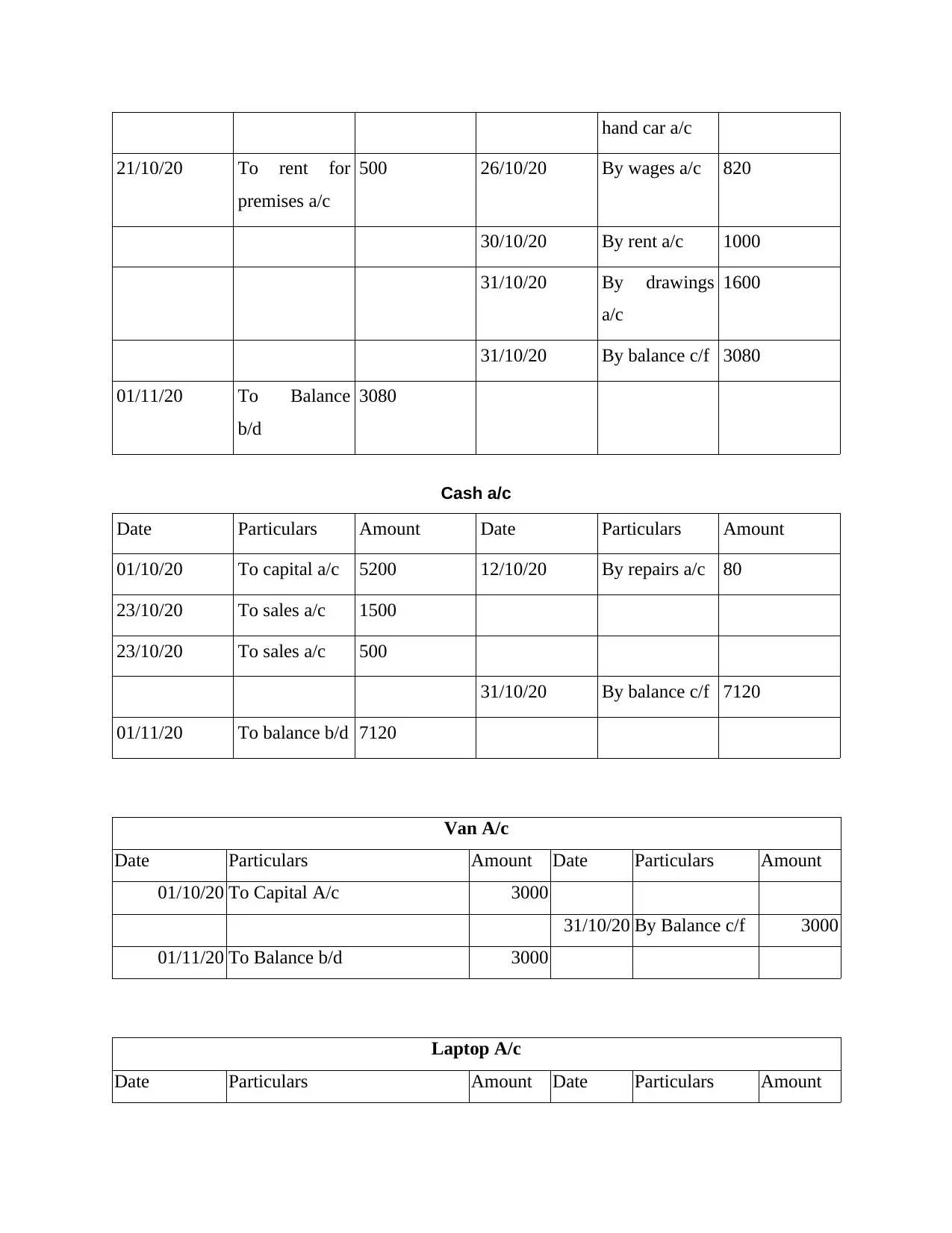
hand car a/c
21/10/20 To rent for
premises a/c
500 26/10/20 By wages a/c 820
30/10/20 By rent a/c 1000
31/10/20 By drawings
a/c
1600
31/10/20 By balance c/f 3080
01/11/20 To Balance
b/d
3080
Cash a/c
Date Particulars Amount Date Particulars Amount
01/10/20 To capital a/c 5200 12/10/20 By repairs a/c 80
23/10/20 To sales a/c 1500
23/10/20 To sales a/c 500
31/10/20 By balance c/f 7120
01/11/20 To balance b/d 7120
Van A/c
Date Particulars Amount Date Particulars Amount
01/10/20 To Capital A/c 3000
31/10/20 By Balance c/f 3000
01/11/20 To Balance b/d 3000
Laptop A/c
Date Particulars Amount Date Particulars Amount
21/10/20 To rent for
premises a/c
500 26/10/20 By wages a/c 820
30/10/20 By rent a/c 1000
31/10/20 By drawings
a/c
1600
31/10/20 By balance c/f 3080
01/11/20 To Balance
b/d
3080
Cash a/c
Date Particulars Amount Date Particulars Amount
01/10/20 To capital a/c 5200 12/10/20 By repairs a/c 80
23/10/20 To sales a/c 1500
23/10/20 To sales a/c 500
31/10/20 By balance c/f 7120
01/11/20 To balance b/d 7120
Van A/c
Date Particulars Amount Date Particulars Amount
01/10/20 To Capital A/c 3000
31/10/20 By Balance c/f 3000
01/11/20 To Balance b/d 3000
Laptop A/c
Date Particulars Amount Date Particulars Amount
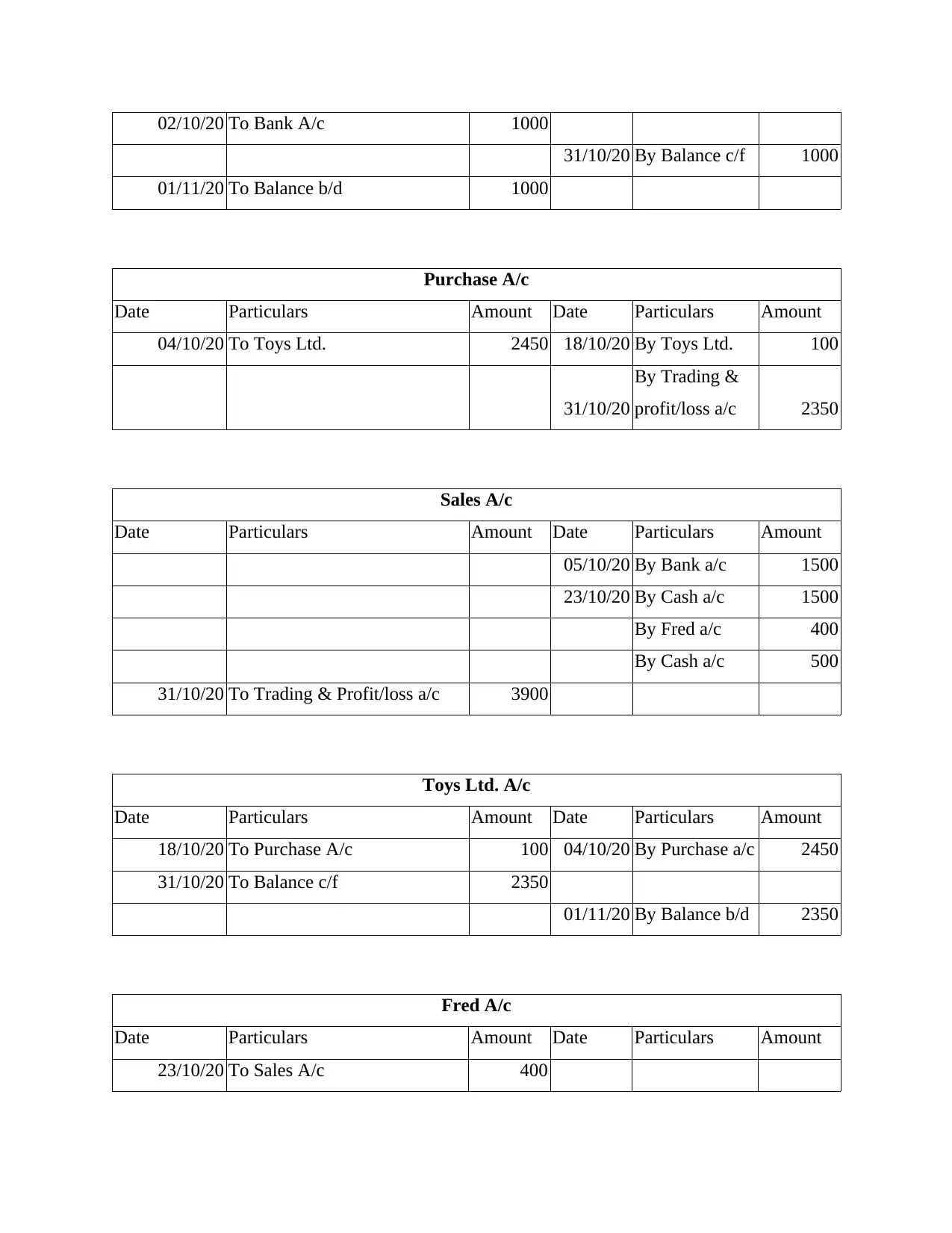
02/10/20 To Bank A/c 1000
31/10/20 By Balance c/f 1000
01/11/20 To Balance b/d 1000
Purchase A/c
Date Particulars Amount Date Particulars Amount
04/10/20 To Toys Ltd. 2450 18/10/20 By Toys Ltd. 100
31/10/20
By Trading &
profit/loss a/c 2350
Sales A/c
Date Particulars Amount Date Particulars Amount
05/10/20 By Bank a/c 1500
23/10/20 By Cash a/c 1500
By Fred a/c 400
By Cash a/c 500
31/10/20 To Trading & Profit/loss a/c 3900
Toys Ltd. A/c
Date Particulars Amount Date Particulars Amount
18/10/20 To Purchase A/c 100 04/10/20 By Purchase a/c 2450
31/10/20 To Balance c/f 2350
01/11/20 By Balance b/d 2350
Fred A/c
Date Particulars Amount Date Particulars Amount
23/10/20 To Sales A/c 400
31/10/20 By Balance c/f 1000
01/11/20 To Balance b/d 1000
Purchase A/c
Date Particulars Amount Date Particulars Amount
04/10/20 To Toys Ltd. 2450 18/10/20 By Toys Ltd. 100
31/10/20
By Trading &
profit/loss a/c 2350
Sales A/c
Date Particulars Amount Date Particulars Amount
05/10/20 By Bank a/c 1500
23/10/20 By Cash a/c 1500
By Fred a/c 400
By Cash a/c 500
31/10/20 To Trading & Profit/loss a/c 3900
Toys Ltd. A/c
Date Particulars Amount Date Particulars Amount
18/10/20 To Purchase A/c 100 04/10/20 By Purchase a/c 2450
31/10/20 To Balance c/f 2350
01/11/20 By Balance b/d 2350
Fred A/c
Date Particulars Amount Date Particulars Amount
23/10/20 To Sales A/c 400
Paraphrase This Document
Need a fresh take? Get an instant paraphrase of this document with our AI Paraphraser
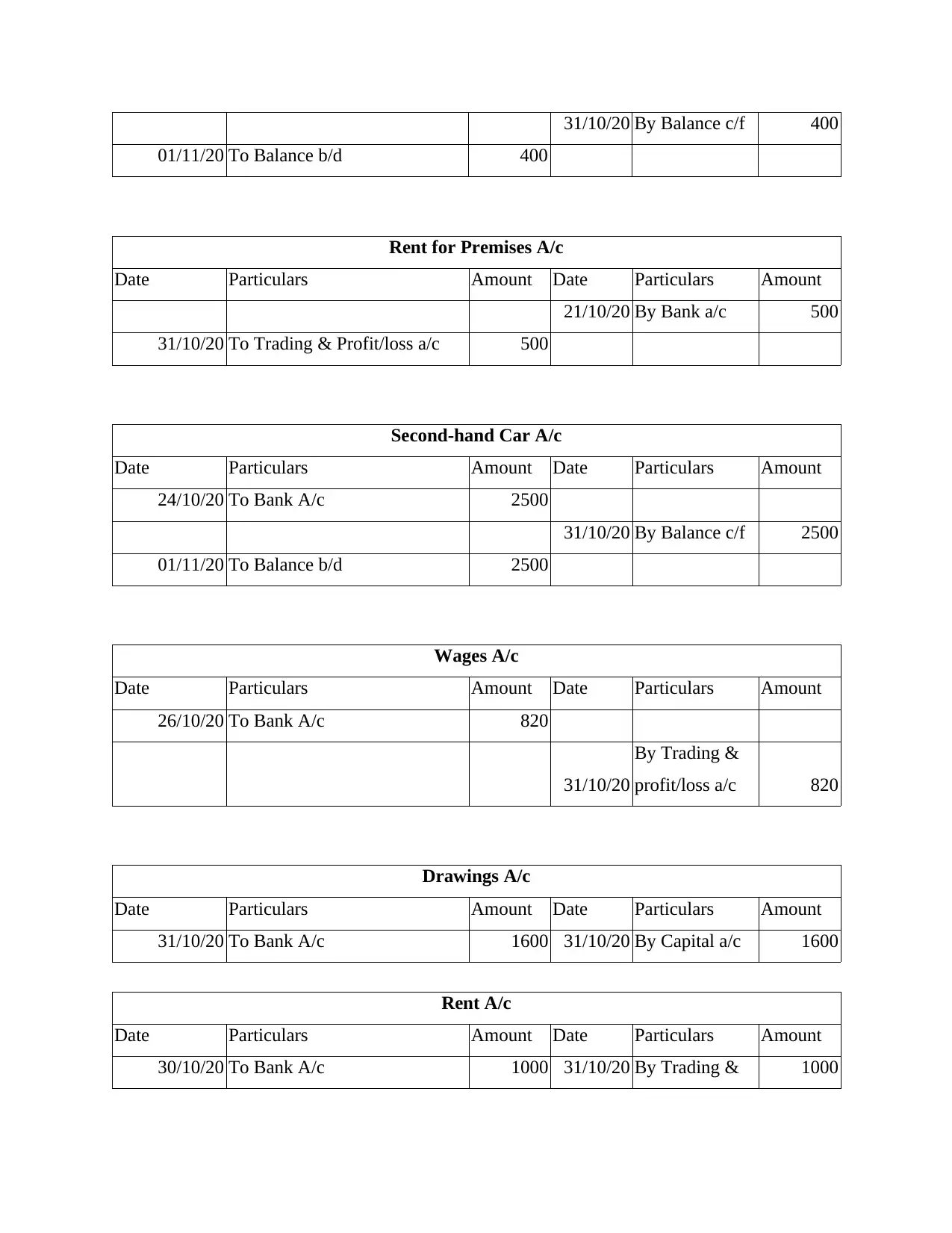
31/10/20 By Balance c/f 400
01/11/20 To Balance b/d 400
Rent for Premises A/c
Date Particulars Amount Date Particulars Amount
21/10/20 By Bank a/c 500
31/10/20 To Trading & Profit/loss a/c 500
Second-hand Car A/c
Date Particulars Amount Date Particulars Amount
24/10/20 To Bank A/c 2500
31/10/20 By Balance c/f 2500
01/11/20 To Balance b/d 2500
Wages A/c
Date Particulars Amount Date Particulars Amount
26/10/20 To Bank A/c 820
31/10/20
By Trading &
profit/loss a/c 820
Drawings A/c
Date Particulars Amount Date Particulars Amount
31/10/20 To Bank A/c 1600 31/10/20 By Capital a/c 1600
Rent A/c
Date Particulars Amount Date Particulars Amount
30/10/20 To Bank A/c 1000 31/10/20 By Trading & 1000
01/11/20 To Balance b/d 400
Rent for Premises A/c
Date Particulars Amount Date Particulars Amount
21/10/20 By Bank a/c 500
31/10/20 To Trading & Profit/loss a/c 500
Second-hand Car A/c
Date Particulars Amount Date Particulars Amount
24/10/20 To Bank A/c 2500
31/10/20 By Balance c/f 2500
01/11/20 To Balance b/d 2500
Wages A/c
Date Particulars Amount Date Particulars Amount
26/10/20 To Bank A/c 820
31/10/20
By Trading &
profit/loss a/c 820
Drawings A/c
Date Particulars Amount Date Particulars Amount
31/10/20 To Bank A/c 1600 31/10/20 By Capital a/c 1600
Rent A/c
Date Particulars Amount Date Particulars Amount
30/10/20 To Bank A/c 1000 31/10/20 By Trading & 1000
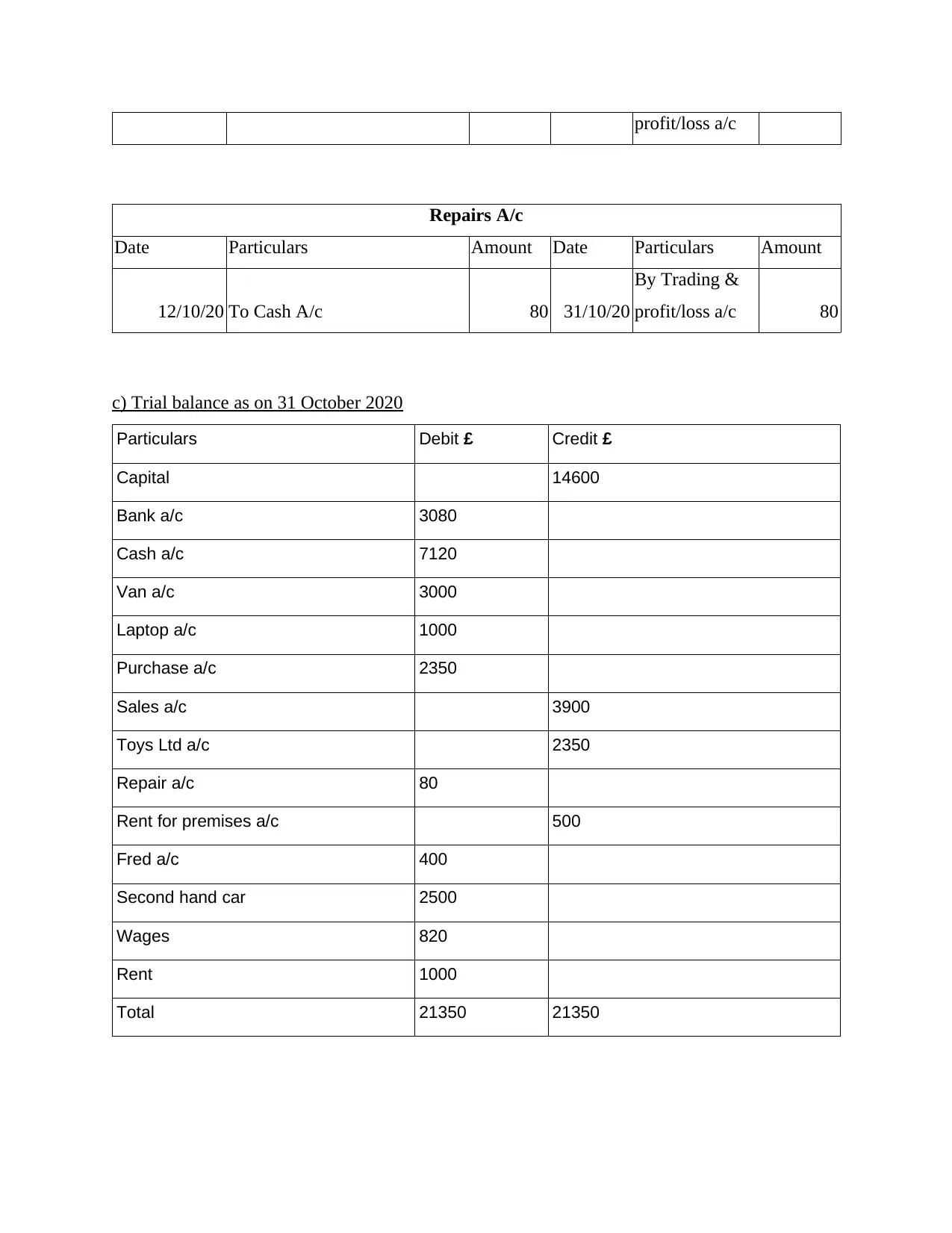
profit/loss a/c
Repairs A/c
Date Particulars Amount Date Particulars Amount
12/10/20 To Cash A/c 80 31/10/20
By Trading &
profit/loss a/c 80
c) Trial balance as on 31 October 2020
Particulars Debit £ Credit £
Capital 14600
Bank a/c 3080
Cash a/c 7120
Van a/c 3000
Laptop a/c 1000
Purchase a/c 2350
Sales a/c 3900
Toys Ltd a/c 2350
Repair a/c 80
Rent for premises a/c 500
Fred a/c 400
Second hand car 2500
Wages 820
Rent 1000
Total 21350 21350
Repairs A/c
Date Particulars Amount Date Particulars Amount
12/10/20 To Cash A/c 80 31/10/20
By Trading &
profit/loss a/c 80
c) Trial balance as on 31 October 2020
Particulars Debit £ Credit £
Capital 14600
Bank a/c 3080
Cash a/c 7120
Van a/c 3000
Laptop a/c 1000
Purchase a/c 2350
Sales a/c 3900
Toys Ltd a/c 2350
Repair a/c 80
Rent for premises a/c 500
Fred a/c 400
Second hand car 2500
Wages 820
Rent 1000
Total 21350 21350
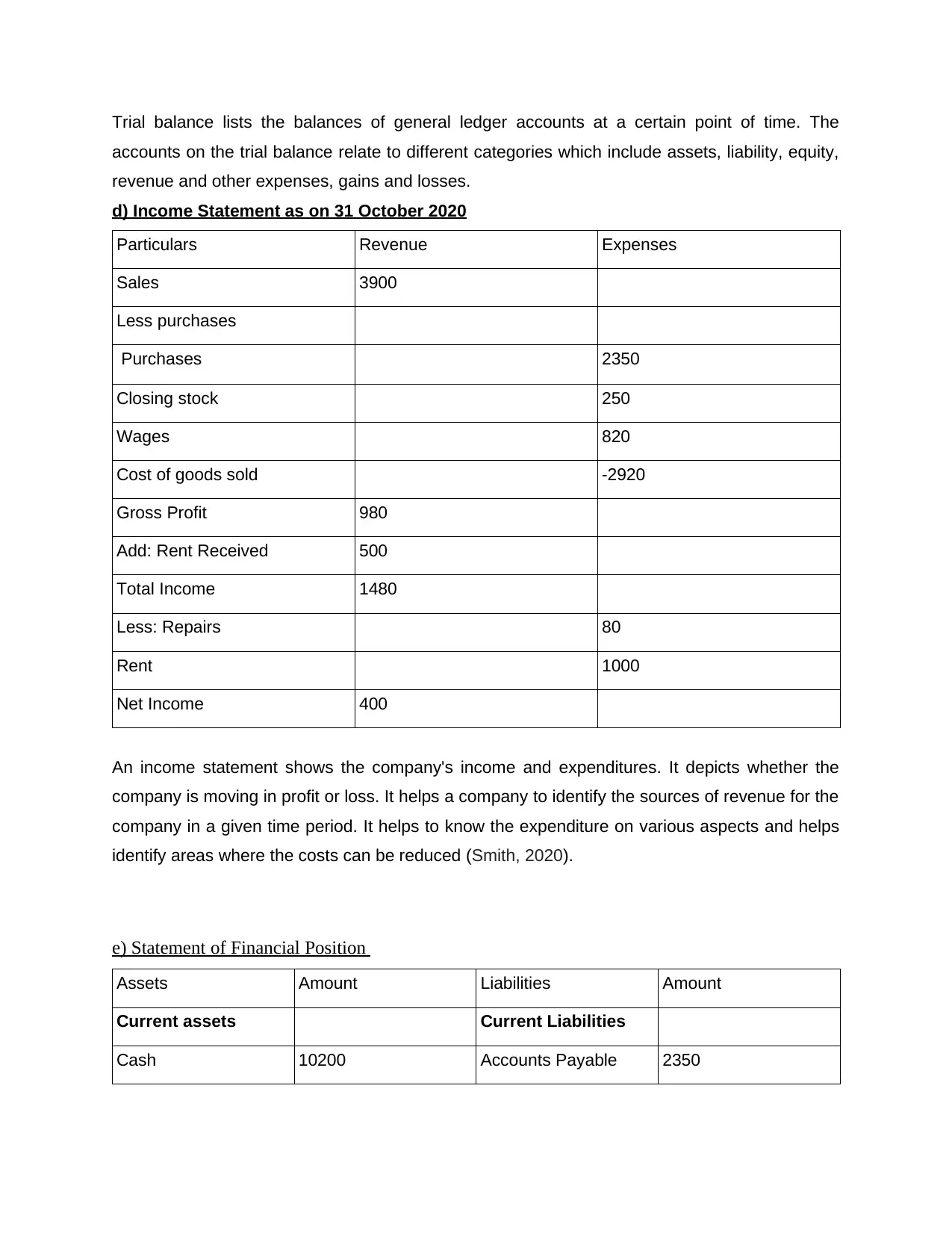
Trial balance lists the balances of general ledger accounts at a certain point of time. The
accounts on the trial balance relate to different categories which include assets, liability, equity,
revenue and other expenses, gains and losses.
d) Income Statement as on 31 October 2020
Particulars Revenue Expenses
Sales 3900
Less purchases
Purchases 2350
Closing stock 250
Wages 820
Cost of goods sold -2920
Gross Profit 980
Add: Rent Received 500
Total Income 1480
Less: Repairs 80
Rent 1000
Net Income 400
An income statement shows the company's income and expenditures. It depicts whether the
company is moving in profit or loss. It helps a company to identify the sources of revenue for the
company in a given time period. It helps to know the expenditure on various aspects and helps
identify areas where the costs can be reduced (Smith, 2020).
e) Statement of Financial Position
Assets Amount Liabilities Amount
Current assets Current Liabilities
Cash 10200 Accounts Payable 2350
accounts on the trial balance relate to different categories which include assets, liability, equity,
revenue and other expenses, gains and losses.
d) Income Statement as on 31 October 2020
Particulars Revenue Expenses
Sales 3900
Less purchases
Purchases 2350
Closing stock 250
Wages 820
Cost of goods sold -2920
Gross Profit 980
Add: Rent Received 500
Total Income 1480
Less: Repairs 80
Rent 1000
Net Income 400
An income statement shows the company's income and expenditures. It depicts whether the
company is moving in profit or loss. It helps a company to identify the sources of revenue for the
company in a given time period. It helps to know the expenditure on various aspects and helps
identify areas where the costs can be reduced (Smith, 2020).
e) Statement of Financial Position
Assets Amount Liabilities Amount
Current assets Current Liabilities
Cash 10200 Accounts Payable 2350
Secure Best Marks with AI Grader
Need help grading? Try our AI Grader for instant feedback on your assignments.
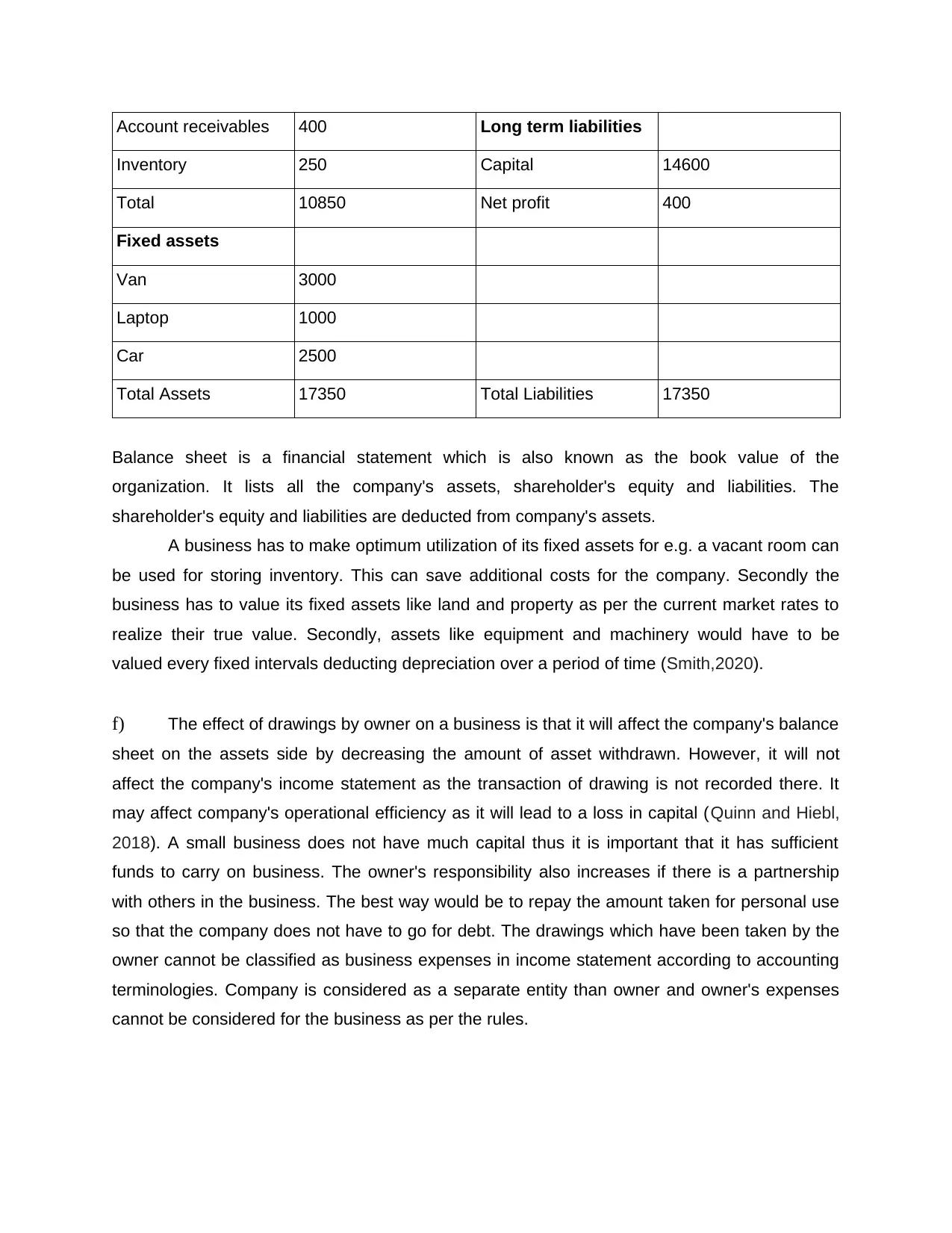
Account receivables 400 Long term liabilities
Inventory 250 Capital 14600
Total 10850 Net profit 400
Fixed assets
Van 3000
Laptop 1000
Car 2500
Total Assets 17350 Total Liabilities 17350
Balance sheet is a financial statement which is also known as the book value of the
organization. It lists all the company's assets, shareholder's equity and liabilities. The
shareholder's equity and liabilities are deducted from company's assets.
A business has to make optimum utilization of its fixed assets for e.g. a vacant room can
be used for storing inventory. This can save additional costs for the company. Secondly the
business has to value its fixed assets like land and property as per the current market rates to
realize their true value. Secondly, assets like equipment and machinery would have to be
valued every fixed intervals deducting depreciation over a period of time (Smith,2020).
f) The effect of drawings by owner on a business is that it will affect the company's balance
sheet on the assets side by decreasing the amount of asset withdrawn. However, it will not
affect the company's income statement as the transaction of drawing is not recorded there. It
may affect company's operational efficiency as it will lead to a loss in capital (Quinn and Hiebl,
2018). A small business does not have much capital thus it is important that it has sufficient
funds to carry on business. The owner's responsibility also increases if there is a partnership
with others in the business. The best way would be to repay the amount taken for personal use
so that the company does not have to go for debt. The drawings which have been taken by the
owner cannot be classified as business expenses in income statement according to accounting
terminologies. Company is considered as a separate entity than owner and owner's expenses
cannot be considered for the business as per the rules.
Inventory 250 Capital 14600
Total 10850 Net profit 400
Fixed assets
Van 3000
Laptop 1000
Car 2500
Total Assets 17350 Total Liabilities 17350
Balance sheet is a financial statement which is also known as the book value of the
organization. It lists all the company's assets, shareholder's equity and liabilities. The
shareholder's equity and liabilities are deducted from company's assets.
A business has to make optimum utilization of its fixed assets for e.g. a vacant room can
be used for storing inventory. This can save additional costs for the company. Secondly the
business has to value its fixed assets like land and property as per the current market rates to
realize their true value. Secondly, assets like equipment and machinery would have to be
valued every fixed intervals deducting depreciation over a period of time (Smith,2020).
f) The effect of drawings by owner on a business is that it will affect the company's balance
sheet on the assets side by decreasing the amount of asset withdrawn. However, it will not
affect the company's income statement as the transaction of drawing is not recorded there. It
may affect company's operational efficiency as it will lead to a loss in capital (Quinn and Hiebl,
2018). A small business does not have much capital thus it is important that it has sufficient
funds to carry on business. The owner's responsibility also increases if there is a partnership
with others in the business. The best way would be to repay the amount taken for personal use
so that the company does not have to go for debt. The drawings which have been taken by the
owner cannot be classified as business expenses in income statement according to accounting
terminologies. Company is considered as a separate entity than owner and owner's expenses
cannot be considered for the business as per the rules.
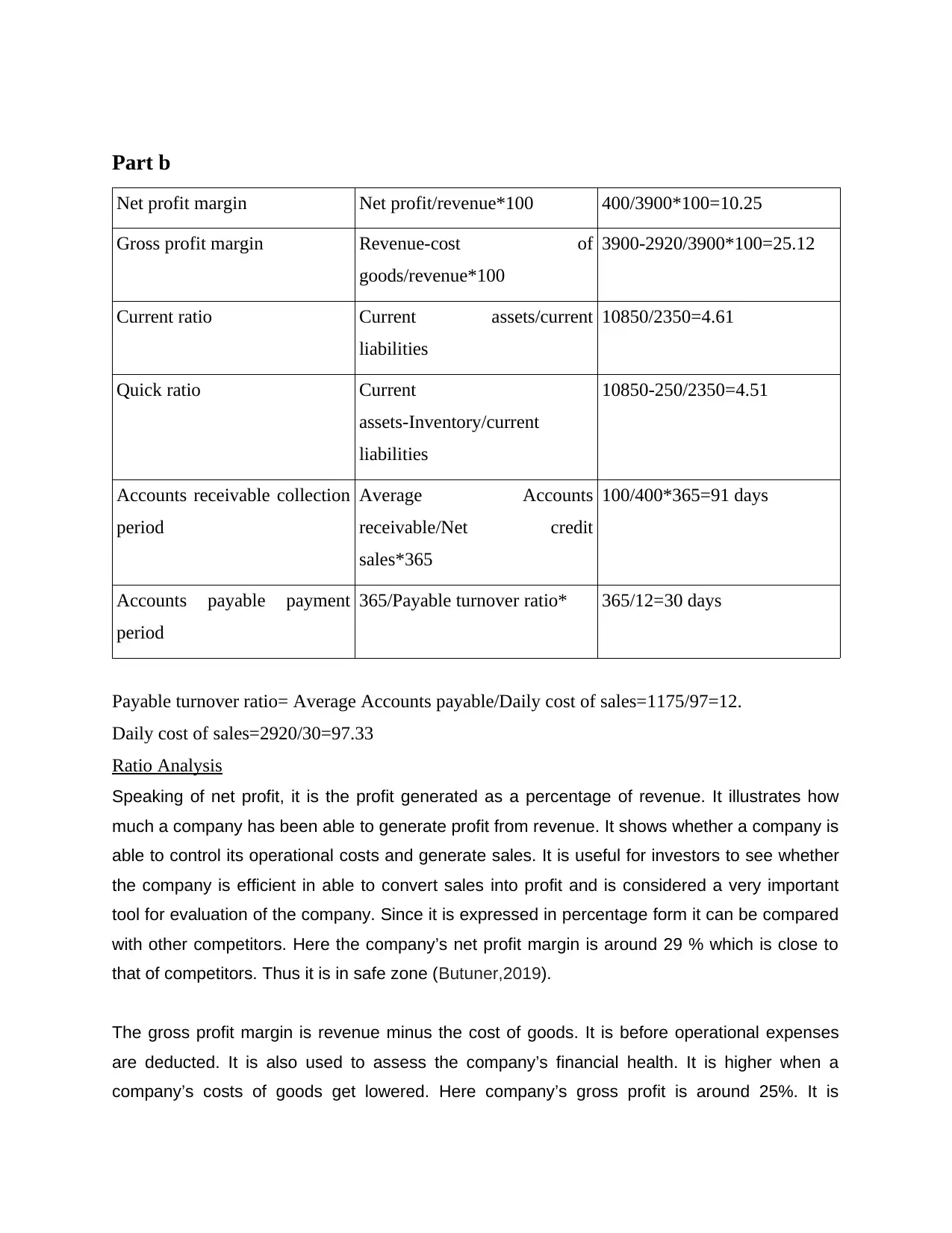
Part b
Net profit margin Net profit/revenue*100 400/3900*100=10.25
Gross profit margin Revenue-cost of
goods/revenue*100
3900-2920/3900*100=25.12
Current ratio Current assets/current
liabilities
10850/2350=4.61
Quick ratio Current
assets-Inventory/current
liabilities
10850-250/2350=4.51
Accounts receivable collection
period
Average Accounts
receivable/Net credit
sales*365
100/400*365=91 days
Accounts payable payment
period
365/Payable turnover ratio* 365/12=30 days
Payable turnover ratio= Average Accounts payable/Daily cost of sales=1175/97=12.
Daily cost of sales=2920/30=97.33
Ratio Analysis
Speaking of net profit, it is the profit generated as a percentage of revenue. It illustrates how
much a company has been able to generate profit from revenue. It shows whether a company is
able to control its operational costs and generate sales. It is useful for investors to see whether
the company is efficient in able to convert sales into profit and is considered a very important
tool for evaluation of the company. Since it is expressed in percentage form it can be compared
with other competitors. Here the company’s net profit margin is around 29 % which is close to
that of competitors. Thus it is in safe zone (Butuner,2019).
The gross profit margin is revenue minus the cost of goods. It is before operational expenses
are deducted. It is also used to assess the company’s financial health. It is higher when a
company’s costs of goods get lowered. Here company’s gross profit is around 25%. It is
Net profit margin Net profit/revenue*100 400/3900*100=10.25
Gross profit margin Revenue-cost of
goods/revenue*100
3900-2920/3900*100=25.12
Current ratio Current assets/current
liabilities
10850/2350=4.61
Quick ratio Current
assets-Inventory/current
liabilities
10850-250/2350=4.51
Accounts receivable collection
period
Average Accounts
receivable/Net credit
sales*365
100/400*365=91 days
Accounts payable payment
period
365/Payable turnover ratio* 365/12=30 days
Payable turnover ratio= Average Accounts payable/Daily cost of sales=1175/97=12.
Daily cost of sales=2920/30=97.33
Ratio Analysis
Speaking of net profit, it is the profit generated as a percentage of revenue. It illustrates how
much a company has been able to generate profit from revenue. It shows whether a company is
able to control its operational costs and generate sales. It is useful for investors to see whether
the company is efficient in able to convert sales into profit and is considered a very important
tool for evaluation of the company. Since it is expressed in percentage form it can be compared
with other competitors. Here the company’s net profit margin is around 29 % which is close to
that of competitors. Thus it is in safe zone (Butuner,2019).
The gross profit margin is revenue minus the cost of goods. It is before operational expenses
are deducted. It is also used to assess the company’s financial health. It is higher when a
company’s costs of goods get lowered. Here company’s gross profit is around 25%. It is
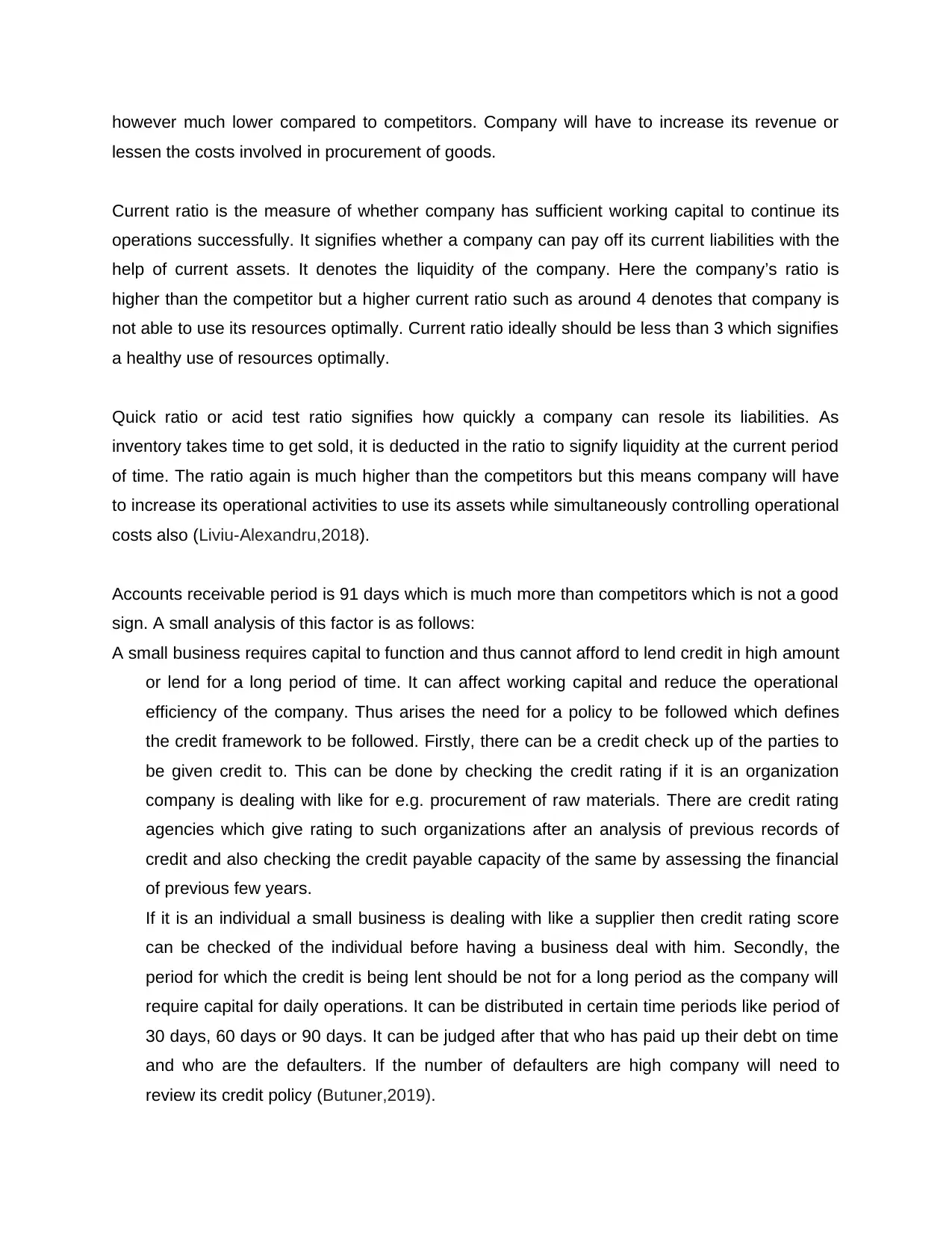
however much lower compared to competitors. Company will have to increase its revenue or
lessen the costs involved in procurement of goods.
Current ratio is the measure of whether company has sufficient working capital to continue its
operations successfully. It signifies whether a company can pay off its current liabilities with the
help of current assets. It denotes the liquidity of the company. Here the company’s ratio is
higher than the competitor but a higher current ratio such as around 4 denotes that company is
not able to use its resources optimally. Current ratio ideally should be less than 3 which signifies
a healthy use of resources optimally.
Quick ratio or acid test ratio signifies how quickly a company can resole its liabilities. As
inventory takes time to get sold, it is deducted in the ratio to signify liquidity at the current period
of time. The ratio again is much higher than the competitors but this means company will have
to increase its operational activities to use its assets while simultaneously controlling operational
costs also (Liviu-Alexandru,2018).
Accounts receivable period is 91 days which is much more than competitors which is not a good
sign. A small analysis of this factor is as follows:
A small business requires capital to function and thus cannot afford to lend credit in high amount
or lend for a long period of time. It can affect working capital and reduce the operational
efficiency of the company. Thus arises the need for a policy to be followed which defines
the credit framework to be followed. Firstly, there can be a credit check up of the parties to
be given credit to. This can be done by checking the credit rating if it is an organization
company is dealing with like for e.g. procurement of raw materials. There are credit rating
agencies which give rating to such organizations after an analysis of previous records of
credit and also checking the credit payable capacity of the same by assessing the financial
of previous few years.
If it is an individual a small business is dealing with like a supplier then credit rating score
can be checked of the individual before having a business deal with him. Secondly, the
period for which the credit is being lent should be not for a long period as the company will
require capital for daily operations. It can be distributed in certain time periods like period of
30 days, 60 days or 90 days. It can be judged after that who has paid up their debt on time
and who are the defaulters. If the number of defaulters are high company will need to
review its credit policy (Butuner,2019).
lessen the costs involved in procurement of goods.
Current ratio is the measure of whether company has sufficient working capital to continue its
operations successfully. It signifies whether a company can pay off its current liabilities with the
help of current assets. It denotes the liquidity of the company. Here the company’s ratio is
higher than the competitor but a higher current ratio such as around 4 denotes that company is
not able to use its resources optimally. Current ratio ideally should be less than 3 which signifies
a healthy use of resources optimally.
Quick ratio or acid test ratio signifies how quickly a company can resole its liabilities. As
inventory takes time to get sold, it is deducted in the ratio to signify liquidity at the current period
of time. The ratio again is much higher than the competitors but this means company will have
to increase its operational activities to use its assets while simultaneously controlling operational
costs also (Liviu-Alexandru,2018).
Accounts receivable period is 91 days which is much more than competitors which is not a good
sign. A small analysis of this factor is as follows:
A small business requires capital to function and thus cannot afford to lend credit in high amount
or lend for a long period of time. It can affect working capital and reduce the operational
efficiency of the company. Thus arises the need for a policy to be followed which defines
the credit framework to be followed. Firstly, there can be a credit check up of the parties to
be given credit to. This can be done by checking the credit rating if it is an organization
company is dealing with like for e.g. procurement of raw materials. There are credit rating
agencies which give rating to such organizations after an analysis of previous records of
credit and also checking the credit payable capacity of the same by assessing the financial
of previous few years.
If it is an individual a small business is dealing with like a supplier then credit rating score
can be checked of the individual before having a business deal with him. Secondly, the
period for which the credit is being lent should be not for a long period as the company will
require capital for daily operations. It can be distributed in certain time periods like period of
30 days, 60 days or 90 days. It can be judged after that who has paid up their debt on time
and who are the defaulters. If the number of defaulters are high company will need to
review its credit policy (Butuner,2019).
Paraphrase This Document
Need a fresh take? Get an instant paraphrase of this document with our AI Paraphraser
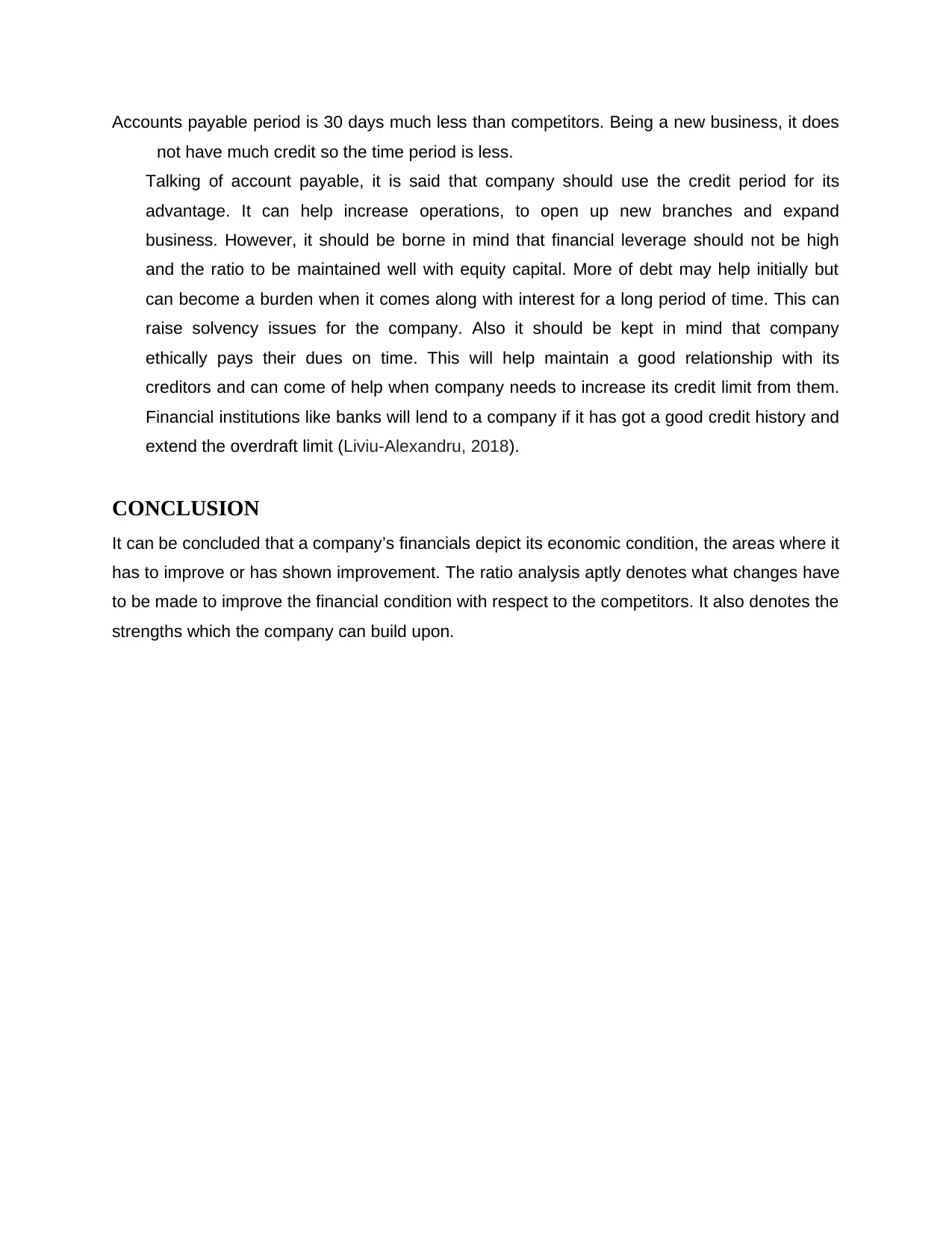
Accounts payable period is 30 days much less than competitors. Being a new business, it does
not have much credit so the time period is less.
Talking of account payable, it is said that company should use the credit period for its
advantage. It can help increase operations, to open up new branches and expand
business. However, it should be borne in mind that financial leverage should not be high
and the ratio to be maintained well with equity capital. More of debt may help initially but
can become a burden when it comes along with interest for a long period of time. This can
raise solvency issues for the company. Also it should be kept in mind that company
ethically pays their dues on time. This will help maintain a good relationship with its
creditors and can come of help when company needs to increase its credit limit from them.
Financial institutions like banks will lend to a company if it has got a good credit history and
extend the overdraft limit (Liviu-Alexandru, 2018).
CONCLUSION
It can be concluded that a company’s financials depict its economic condition, the areas where it
has to improve or has shown improvement. The ratio analysis aptly denotes what changes have
to be made to improve the financial condition with respect to the competitors. It also denotes the
strengths which the company can build upon.
not have much credit so the time period is less.
Talking of account payable, it is said that company should use the credit period for its
advantage. It can help increase operations, to open up new branches and expand
business. However, it should be borne in mind that financial leverage should not be high
and the ratio to be maintained well with equity capital. More of debt may help initially but
can become a burden when it comes along with interest for a long period of time. This can
raise solvency issues for the company. Also it should be kept in mind that company
ethically pays their dues on time. This will help maintain a good relationship with its
creditors and can come of help when company needs to increase its credit limit from them.
Financial institutions like banks will lend to a company if it has got a good credit history and
extend the overdraft limit (Liviu-Alexandru, 2018).
CONCLUSION
It can be concluded that a company’s financials depict its economic condition, the areas where it
has to improve or has shown improvement. The ratio analysis aptly denotes what changes have
to be made to improve the financial condition with respect to the competitors. It also denotes the
strengths which the company can build upon.
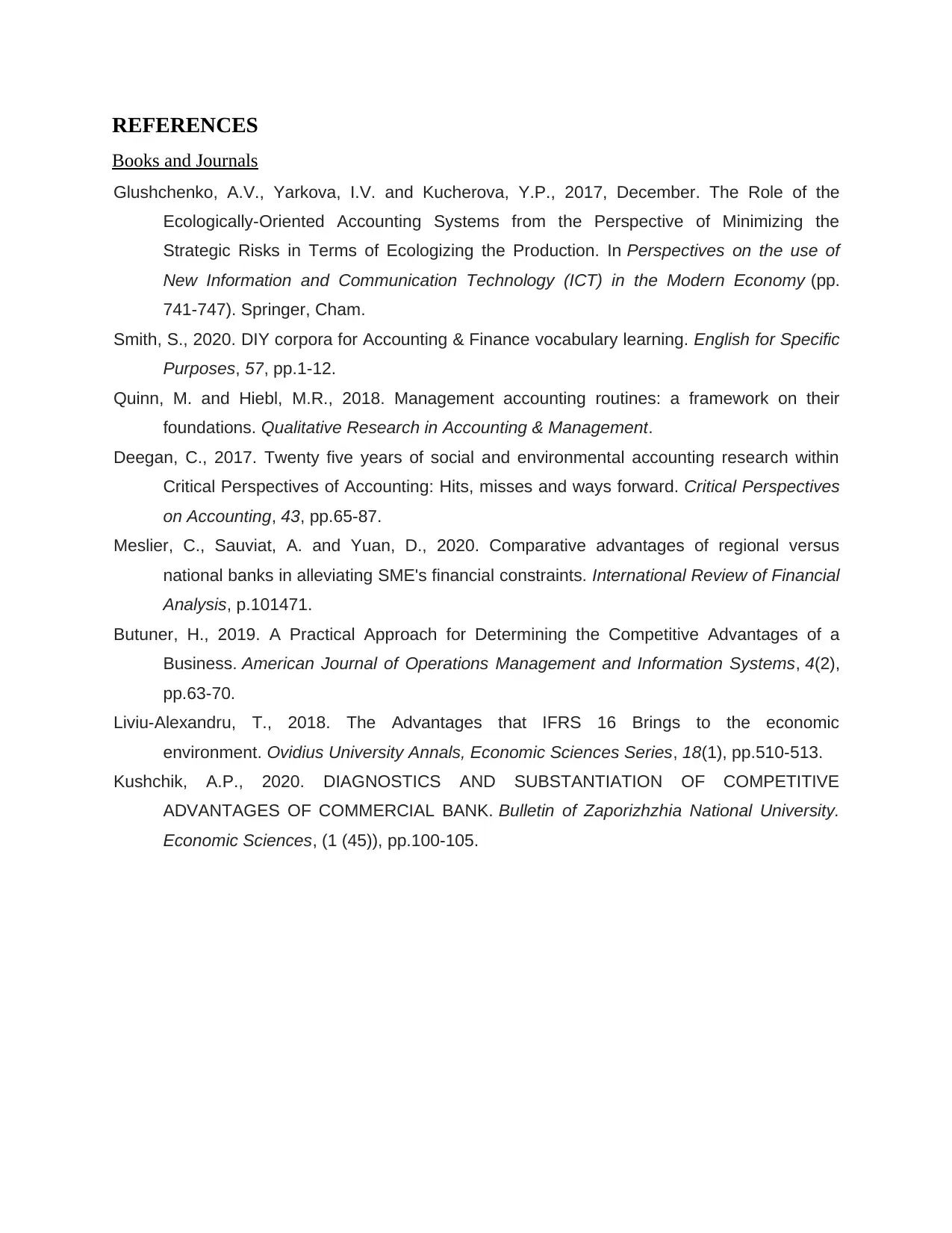
REFERENCES
Books and Journals
Glushchenko, A.V., Yarkova, I.V. and Kucherova, Y.P., 2017, December. The Role of the
Ecologically-Oriented Accounting Systems from the Perspective of Minimizing the
Strategic Risks in Terms of Ecologizing the Production. In Perspectives on the use of
New Information and Communication Technology (ICT) in the Modern Economy (pp.
741-747). Springer, Cham.
Smith, S., 2020. DIY corpora for Accounting & Finance vocabulary learning. English for Specific
Purposes, 57, pp.1-12.
Quinn, M. and Hiebl, M.R., 2018. Management accounting routines: a framework on their
foundations. Qualitative Research in Accounting & Management.
Deegan, C., 2017. Twenty five years of social and environmental accounting research within
Critical Perspectives of Accounting: Hits, misses and ways forward. Critical Perspectives
on Accounting, 43, pp.65-87.
Meslier, C., Sauviat, A. and Yuan, D., 2020. Comparative advantages of regional versus
national banks in alleviating SME's financial constraints. International Review of Financial
Analysis, p.101471.
Butuner, H., 2019. A Practical Approach for Determining the Competitive Advantages of a
Business. American Journal of Operations Management and Information Systems, 4(2),
pp.63-70.
Liviu-Alexandru, T., 2018. The Advantages that IFRS 16 Brings to the economic
environment. Ovidius University Annals, Economic Sciences Series, 18(1), pp.510-513.
Kushchik, A.P., 2020. DIAGNOSTICS AND SUBSTANTIATION OF COMPETITIVE
ADVANTAGES OF COMMERCIAL BANK. Bulletin of Zaporizhzhia National University.
Economic Sciences, (1 (45)), pp.100-105.
Books and Journals
Glushchenko, A.V., Yarkova, I.V. and Kucherova, Y.P., 2017, December. The Role of the
Ecologically-Oriented Accounting Systems from the Perspective of Minimizing the
Strategic Risks in Terms of Ecologizing the Production. In Perspectives on the use of
New Information and Communication Technology (ICT) in the Modern Economy (pp.
741-747). Springer, Cham.
Smith, S., 2020. DIY corpora for Accounting & Finance vocabulary learning. English for Specific
Purposes, 57, pp.1-12.
Quinn, M. and Hiebl, M.R., 2018. Management accounting routines: a framework on their
foundations. Qualitative Research in Accounting & Management.
Deegan, C., 2017. Twenty five years of social and environmental accounting research within
Critical Perspectives of Accounting: Hits, misses and ways forward. Critical Perspectives
on Accounting, 43, pp.65-87.
Meslier, C., Sauviat, A. and Yuan, D., 2020. Comparative advantages of regional versus
national banks in alleviating SME's financial constraints. International Review of Financial
Analysis, p.101471.
Butuner, H., 2019. A Practical Approach for Determining the Competitive Advantages of a
Business. American Journal of Operations Management and Information Systems, 4(2),
pp.63-70.
Liviu-Alexandru, T., 2018. The Advantages that IFRS 16 Brings to the economic
environment. Ovidius University Annals, Economic Sciences Series, 18(1), pp.510-513.
Kushchik, A.P., 2020. DIAGNOSTICS AND SUBSTANTIATION OF COMPETITIVE
ADVANTAGES OF COMMERCIAL BANK. Bulletin of Zaporizhzhia National University.
Economic Sciences, (1 (45)), pp.100-105.
1 out of 15
Related Documents
Your All-in-One AI-Powered Toolkit for Academic Success.
+13062052269
info@desklib.com
Available 24*7 on WhatsApp / Email
![[object Object]](/_next/static/media/star-bottom.7253800d.svg)
Unlock your academic potential
© 2024 | Zucol Services PVT LTD | All rights reserved.





